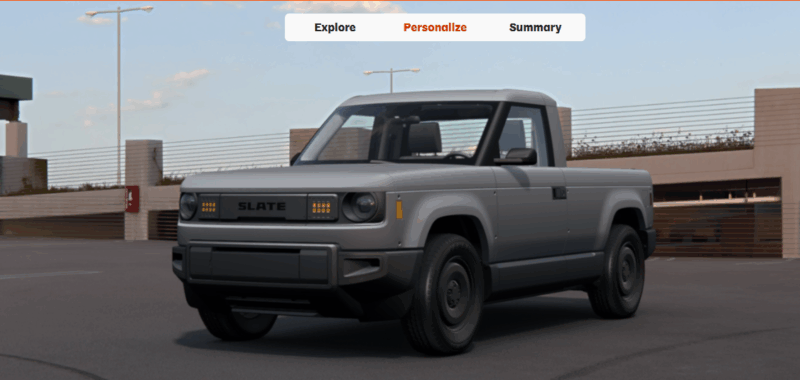Buyers shopping for a basic EV truck might prefer Slate over Tesla or Rivian.
Have you heard about the new Slate electric truck? Because Tesla (TSLA 0.30%) and Rivian Automotive (RIVN -5.93%) certainly have. And if you’re an investor in either of these two leading electric vehicle (EV) stocks, you should definitely be keeping an eye on Slate.
And if you have not heard about Slate yet, here’s what you need to know.
First and foremost, you need to know that the threat Slate poses to Tesla and Rivian is of the not-quite-yet variety. Although backed by multiple well-heeled financiers, billionaire Jeff Bezos among them, Slate is an electric car company still firmly in start-up mode. Media reports indicate (but Slate is not yet confirming), that Slate EV truck deliveries probably won’t begin before the final quarter of 2026. That said, pre-orders of Slate trucks, secured by a refundable $50 deposit, began last week.
It’s likely they’ve already begun to affect sales of Tesla Cybertrucks and Rivian R1T and R1S vehicles.
What is Slate?
Slate describes its new electric truck as “the most radically simple, wildly personalizable vehicle out there,” designed in California and assembled in Michigan (or perhaps Indiana — here’s some confusion on this point). At its basest level, Slate is a tiny two-door RWD pickup. It’s roughly the size of an early 2000s-era standard cab Ford Ranger, but two feet shorter in length than a modern Ford Maverick hybrid pickup, for example, and much smaller than Tesla’s or Rivian’s trucks.
Slate is building interest in the new vehicle by advertising it at “an expected price of under $20,000 after federal incentives,” which implies a base price of perhaps $27,000, minus a federal tax credit of $7,500 for U.S.-built electric vehicles.
Compare that to Cybertruck’s $69,990 entry price, the $71,700 a base Rivian R1T will cost you, or the $77,700 MSRP on a Rivian R1S, and you can see right away why Slate is attracting interest, and probably stealing away market share from its rivals.
Of course, all of the above are advertised base model prices. Start adding options, and each of the EVs named above skyrockets in cost. (Cybertruck, for example, is described as the best-selling vehicle in America, “priced above $100,000,” which tells you few shoppers are finding Cybertrucks for under $70,000.) And Slate already has “nearly four dozen accessories” available for add-on.
All of which got me thinking. I’m a cheapskate at heart, and I’d really like to see if it’s possible to build a Slate truck for something close to its advertised price. Is that possible? And would a cheap Slate truck be worth owning?
So I decided to find out.
How I built my Slate
Logging onto Slate’s website, I set up an account and paid the $50 reservation fee — then started building.
I began with what’s called the Blank Slate, a 150-mile range electric truck in two-door pickup configuration, adding only a spare tire carrier to the rear liftgate, which required adding a bigger rear bumper. I skipped right past options to add decals or “wrap” the Slate in a different color. (Colors are added by wrapping, rather than painting, on Slate). I similarly skipped upgrades for all-terrain tires and bigger tires, and left the wheels alone as well. And I declined an upgrade to a 240-mile range battery pack.
I might rethink that decision later.
Headlights and brake lights? The basics work for me. Likewise most interior colors, including for seat, armrest, steering wheel, and window crank — yes, Slate has manual windows. I did add contrasting colors for climate control dials and key fob, to make them easier to find in the dark.
For the floor, I chose an easy-to-clean rubber floor liner, and rubber floor mats, figuring for a completely new truck model, it might a while before Walmart stocks mats that fit.
The big decision was on the stereo. Slate offers the option to “bring your own” configuration in which neither stereo nor speakers are installed. Instead, you can add a speaker mount, phone holder, and Bluetooth controls on the steering wheel. Then buy a Bluetooth speaker on Amazon.com (AMZN 2.06%), plug it in and connect it to your phone. Abracadabra, you’ve got a pack ‘n’ play entertainment center that never goes obsolete — because when it does, you can just switch it out for the latest tech.
Slate actually recommends this option. I have a hunch Amazon likes the idea, too, as do I.

Image source: Slate.
Summing up my Slate EV truck
Ultimately, I still probably skipped 90% of the “personalization” steps Slate offered, all in the interest of getting a basic, usable electric truck for a price as low as humanly possible. And did it work?
I hope so. Slate doesn’t actually show the price effect of any of its personalization options, not even for the battery upgrade, which I suspect affects MSRP significantly. When all’s said and done, I couldn’t tell you exactly how much my Slate build will cost.
Still and all, the vast majority of the personalization options seem entirely skippable, without affecting the functionality of the truck (aside from the battery upgrade, that is, or the option of converting the pickup into an SUV). This suggests that buying a bare-bones Slate for close to the advertised price — again, that’s under $20,000 after government tax incentives — is in fact entirely doable, as the company claims it is.
Just the prospect alone, and the promise of deliveries starting perhaps 18 months from now, could drain significant demand away from Tesla and Rivian. For a chance to save 70% off the cost of a new electric truck, I can afford to wait.

